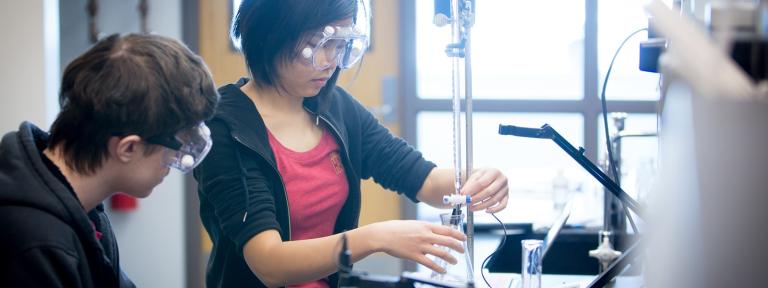
It looks like a large copy machine sitting in the shallow coastal waters of Saginaw Bay, but it is actually a sophisticated voltammetric microelectrode device being used to sample sediments in the bay.
At what researchers from Kettering University have labeled the "Jones Road site," just east of Bay City, and the "Filion Road site," 30 miles up the coastline in Wildfowl Bay, the Au/Hg solid state voltammetric microelectrode system takes incremental measurements of water and sediment, looking for the point where oxygen leaves off and metal sulfides begin. The system takes measurements at one half millimeter intervals, using microelectrodes made of gold wire plated with a small amount of mercury. The measurements are actually made on mercury.
"The thrust of the project is to look at metals in sediments, and their potential for remobilizing," said Brent Lewis, associate professor of Environmental Chemistry at Kettering. "The metals, like copper, lead and zinc, are locked in the sediments. It is preferable that they stay in place (not remobilize), but seasonally there can be changes in the amount of oxygen and the amount of sulfide in the sediments that will change the phases of those metals," said Lewis. A change is phase translates into diffusing the metals out of the sediment and back into the water column.
"Our goal is to look at the underlying chemical and biological processes that control the cycling of the metals, to better understand the system," he said.
"Of the two sites that we have selected, the Jones Road site is the one that is probably going to be fairly contaminated. A lot of the input is atmospheric, coming from nearby industrial sources. The area has about a 100-year history of industrial activity," Lewis said. "In Wildfowl Bay, the surrounding area is largely rural, making it a relatively uncontaminated control site," he added.
What's going on in sediment:
Bacteria that live in the sediment and break down organic matter "burn", or oxidize, organic carbon for food. To do this, they first they use up oxygen and that strips all the oxygen out of the water. Once they consume the oxygen, then other bacteria take over that can use chemicals other than oxygen to burn carbon,, like iron, manganese, or sulfate, and they convert sulfates into sulfides. Down where the oxygen is completely gone (anoxic conditions), the sulfate reduction kicks in and starts to build up sulfides. As sulfides build the metals are trapped in those sulfide phases. These processes happen on a fine scale with depth in the sediments, and that is why the researchers are using a voltammetric microelectrode system.
The traditional method of collecting samples involves taking cores, extruding the mud and sectioning it. The drawbacks include smearing of the core and relatively thick quarter to half centimeter thick slices. It also requires transporting the cores from the field to the lab, which can itself alter the chemistry. "You don't get as much detail as you would with electrodes," said Lewis, "With the new system you can get enough data points and profiles that you can begin to make calculations. How steeply these curves come up tells us something about the rate at which processes are occurring."
"The working voltammetric electrode is fastened into a micromanipulator, so we can go into the sediment one half millimeter at a time. This device allows us to get real-time data and do it in the field with a minimum of disturbance," he said. "The oxygen disappears in the first one to four millimeters, and in some cases the oxygen may be gone out of the overlying water before we even hit the sediment," said Lewis.
To track seasonal changes in sediment chemistry, measurements and samples are being collected every three months for a year. So far, three samples have been taken at each site, in August and November of 2003, and February of 2004. This means Lewis and student researchers Eric Kannisto, of Macomb, and Paul Montbriand, of Hazel Park, had to transport the copy-machine-sized system through wetlands, spend hours waiting for it to sample a one half millimeter of sediment at a time and then bring the whole system back to campus.
Their findings show that seasonal changes have an oxygenating effect on sediment. In warm weather there were very high levels of sulfides in the sediment, meaning metals were contained and fairly inert. In the fall months, the sulfide levels dropped way down, potentially starting the re-oxidizing of those metal sulfide phases. February samples show sandy sediments have a fairly high potential to re-mobilize metals during the winter months. What is locked in place in the summer may not stay there over the course of the entire year, potentially making the water more "polluted" by metals in winter.
In addition to sampling in real time, the other half of the project is to take the mud itself, and do selective chemical extractions for the different solid phases of metal sulfides and metal oxides, to see how things change both through the cores depth and then seasonally. "We've been sectioning the cores one half centimeter at a time and we'll extract the metals from those muds," said Lewis, "using acids to leach the metals out of the samples, a process called chemical extraction.'Funding for the two-year project was provided by the Michigan Sea Grant program, a research partnership of the National Oceanographic and Atmospheric Administration (NOAA), U.S. Department of Commerce.
Lewis, Kannisto and Montbriand, have presented their early findings and research abstracts at the American Geophysical Union (AGU) Ocean Sciences meeting in Portland Oregon in January. The Saginaw Bay work will also be presented in May at the International Association for Great Lakes Research meeting in Waterloo, Ontario.
Written by Dawn Hibbard
(810) 762-9865
dhibbard@kettering.edu